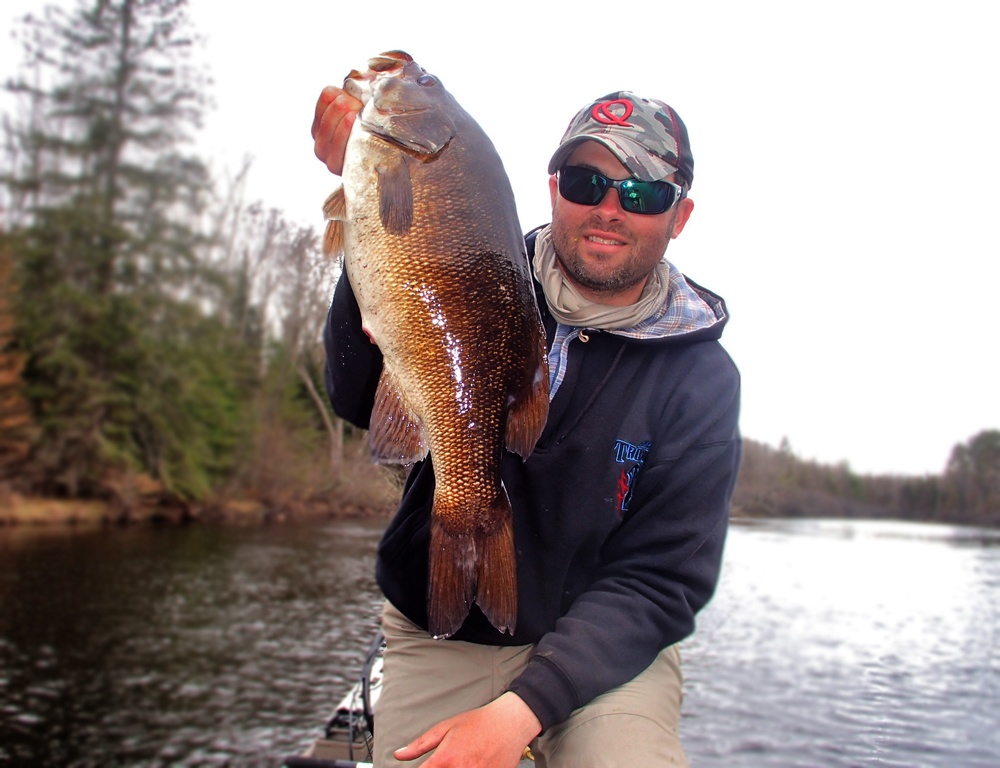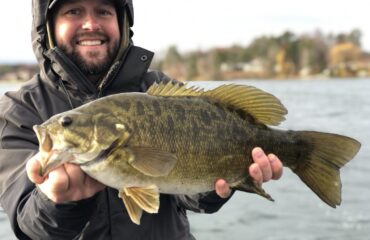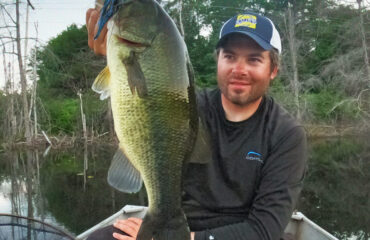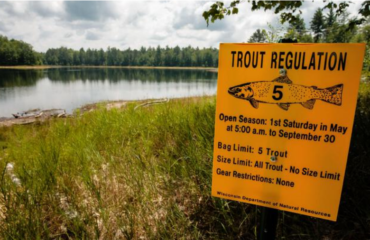River Smallmouth and Timing Spring Migrations
By Andrew Ragas
Much has been studied, discussed, and written about in recent years about fall season river migrations when smallmouth travel downstream to their overwintering sites. On your river, smallmouth could be year-round residents. On my specific rivers in Wisconsin, most of their smallmouth populations are non-resident. Through personal experience and data to now support my findings, little has been shared about upstream spring migrations from flowage to river, ice-out to pre-spawn.
Nearly 10 years ago, I was able to first connect the dots to my favorite river system and its tributaries. Without much known DNR data to support my own theories, I sought out to understand why my favorite pools of the river system were loaded in May and June and mostly devoid of smallmouth thereafter. I struggled to understand why my river smallmouths were in abundance for 4 weeks out of the year, and then no longer present. Considering I’m always floating somewhere in between two flowages, often with one usually located both upstream and downstream of me, it dwelled on me how highly migratory riverine smallmouth bass can be. If free to navigate without obstructions, they’ll migrate long-distance like all other river fish species are capable of.
Smallmouth bass are more migratory than anglers and fisheries biologists believe them to be. Although their seasonal movements are of interest to fishermen, biologists haven’t yet calculated how far smallmouths would migrate without dams. Some studies by the American Fisheries Society suggest that “Northern reaches of smallmouth bass range exhibit long distance migrations, upwards of 25 to 60 miles in length due to severe winters and extensive high water.” What also hasn’t been documented are the massive spawning migrations I’ve independently studied this last decade, and pursue each spring.
Smallmouth Telemetry
Roughly 84,000 miles of rivers and streams flow through the state of Wisconsin, with many of these stream miles supporting migratory fish species. Much of Wisconsin’s waterways are inter-connected and formed by a series of reservoirs and flowages. River systems such as the Flambeau, Chippewa, Wisconsin, Wolf, Black, Peshtigo, and Menominee contain world class populations and sizes of smallmouth bass.
What population percentage of this species is comprised of non-resident migrant fish that travel back and forth between the river and its flowages?
A staggering number of them are proven to be non-resident fish. Without the creation of their flowages in the early to mid 1900’s, many of these rivers don’t support the same quality fisheries they hold today.
In a well-known study of seasonal migration of smallmouth bass in the Embarrass and Wolf rivers in Wisconsin led by biologists, Ross Langhurst and Dean Schenike, of the Wisconsin DNR, the much more closely studied fall overwintering migrations began as water temperature fell to 61°F in autumn – right at around the September 21st autumnal equinox. This tracking study is groundbreaking for proving smallmouths can migrate for more than 70 miles from summer to wintering habitats in that specific river system. On other river systems where barrier-free, smallmouth will conversely migrate long distances, returning upstream to their spring and summer habitats. This annual spawning migration begins soon after ice out.
Prior to this WI-DNR study, little had been documented about migration patterns and tendencies. River smallmouths were previously believed to spend most of their lives within 5 miles of where they hatched. My findings and catch data contradicted. Most smallmouth bass I catch from rivers late in the year come from locations several miles away from their spawning sites.
More research effort and catch data is shedding new light on smallmouth telemetry and migratory behavior.
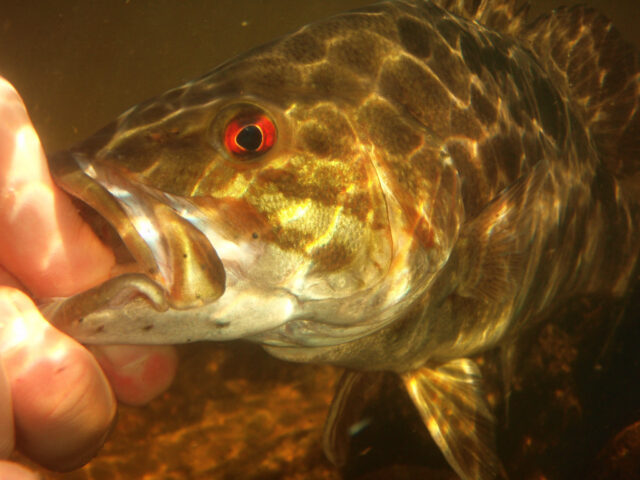
A high percentile of river smallmouth on northern Wisconsin’s river systems are migrants. Where barrier-free, these non-resident fish are exhibiting migratory distances surpassing 70 miles length.
Migration Programming
On many river systems throughout Wisconsin, a small percentile of their populations is sedentary year round residents, while a majority is non-resident and nomadic, traveling long distance for overwintering and spawning. Every spring, the same fish return upstream after ice-out, and as dictated by current discharge rates, and optimal water temperature.
River spawning requires ideal water level as nests can be best-protected near shore and in current breaks. High water and flooding will signal to fish and influence their drive upstream into the system, but leads to poorer hatching success and recruitment. Smallmouth bass are creatures of habit. They don’t know any better than what’s been repetitive to their lifetimes.
Speaking of repetition, the same adult fish return upstream to me every year in May where we will enjoy ones company over the course of 4 weeks. The same nesting sites and leftover nests of last year get re-used too. Whether by same individual fish, the data is inconclusive. This is where some tagging and recapturing studies should be considered by state biologists to better learn about river nesting habits and revisiting.
Water temperature must be optimal as well. It’ll single-handedly influence a river migration in spring. 40 degree range, it’s too cold. Nothing but spawning walleyes and post-spawn northern pike are in the flow. At 48 to 52, we’ll finally find some smallmouth success, but only from isolated staging sites. Good luck ever locating them as 99% of the river will be vacant. Middle 50’s and slowly climbing, we’re getting hot! River’s loaded, and we’ll have a bonanza through spawn’s conclusion in early June where 50 fish a trip is to be expected.
When they have an inter-connected network of flowages and tributaries to move in and out from, river smallmouth can migrate like clockwork and be predictable during each migration season. When you understand and identify the intricacies and nuances of a system, you’ll be in the zone with it, and so too will your fishing. Importantly, know when and where to fish your pools as it pertains to each season and its phases, and during each particular migration period.
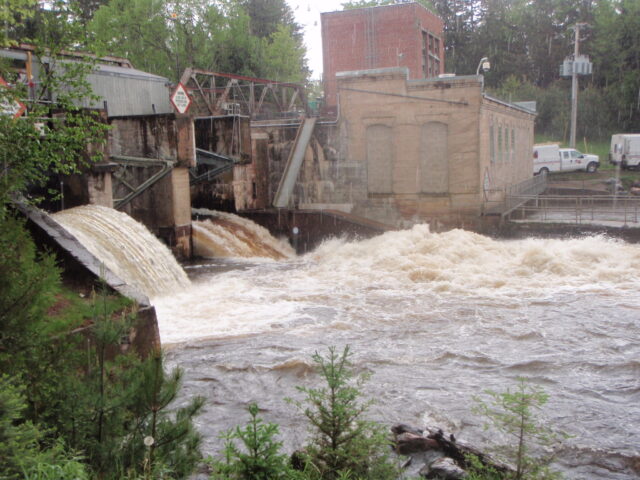
Discharge rate (flows), and water temperature are the driving forces of river upstream migrations in spring.
A Guide’s Day-Off Smallmouth Study
A rare but deserving day-off greeted me in the middle of what had been the most grueling and demanding of May guiding months. What’s a guide to do on his me-day? 99 out of 100 times, I’ll rig-up my river jon and settle for the next river adventure.
Another late ice-melt delayed the arrival and progression of spring, likewise delaying the anticipation of the annual river run of smallmouth.
I arrived at my put-in site on an overcast, chilly early morning to find river water level at normal pool and discharge rate for the first spring in the last 4 seasons. When high and flooded like it had been for the past 4 springs, it’s totally unfishable. When perfection flows, good fishing often follows. Only problem, water temperature was 49 with smallmouth nowhere to be found for the first 2 miles of the float.
I pressed onward and downstream for another mile of frustration casting. 3 hours into the float, and still no fish. Since fish hadn’t yet infiltrated through the system, continuing downstream to the first known staging pool was going to be my only opportunity of this trip.
The staging pool had been visited and fished often for the prior 10 seasons since first making its discovery. The area, about the size of a basketball half-court, is largely an eddy and current seam with sand and gravel bottom, also featuring a scattering of large emergent boulders that blockade the current chute running down the middle. Average depth of the entire pool varies from 3 to 5 ft. What makes this pool further attractive are its undercut banks and tree limbs providing immediate depth and shelter to fish underneath. I’m convinced this spot congregates the same individual smallmouth every spring to host their spawn.
I’ve been in this exact fishless position before, relying on a staging pool, having reaped the rewards of its isolated location and staging smallmouth. It’s historic to this river’s migrant smallmouth population – tradition and information that is passed down to them by their ancestors.
To prevent spooking, I quietly drifted past the pool without any motor use, only to turn the jon around with the MinnKota Edge and proceeded face-forward into the current to cast upstream.
First cast with my red crawdad Rapala DT-4 crankbait, my first 20 incher of the season came to hand. Following admiration and release, a second 20 incher was captured 3 casts later.
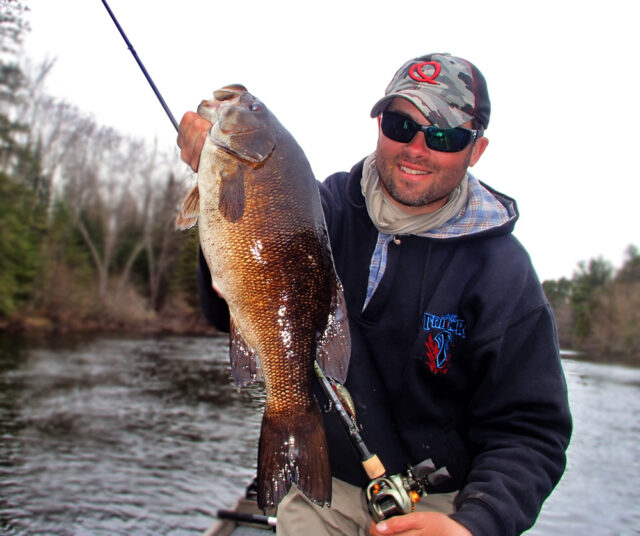
Big fish every 5 to 10 casts continued for the next 2 hours until I exhausted the pool from every casting angle, conditioning its staging fish. A total of 25 smallmouth were caught and released. Each one of them measured 19 to 21 inches length. I’m also convinced many of these same fish had been caught on spring floats in prior years.
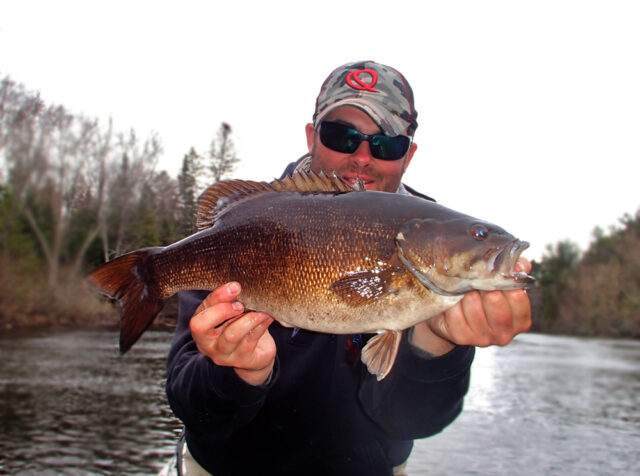
Without river rat intuition and an extensive history with the river system, I could have otherwise blown through the staging pool unbeknownst and without ever testing it with the crankbait. It’s easy to ignore staging sites on rivers. Most anglers wouldn’t know how to identify one. Good spots like this one get revisited and used annually by the same fish.
The smallmouths of this pool migrate several miles upstream from the flowage located far downriver, which is about a 20 mile run for them. On this mid-May day, a huge concentration of smallmouth made a pit stop at the staging pool. Perhaps by the next warm spell, or whenever waters encroach 55, they’ll disperse and infiltrate further up river to feed further, then spawn behind every available current break & boulder, log jam, sandy bottom undercut bank, and near-shore and main stem eddy. Many of those same staging smallmouth I caught will also spawn within that same gigantic eddy collecting them!
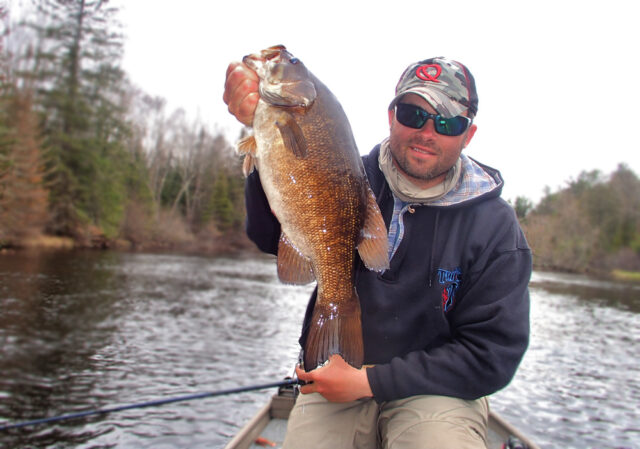
After exhausting the pool, I continued another half-mile further downstream to my end point. A few scattered fish were here and there, but not worth pursuing further. I could have continued several miles further downstream towards the flowage mouth, but there was no motoring back to my vehicle and trailer through the maze of rapids that would have trapped me, or wrecked the prop. Furthermore, there weren’t too many more nearly as good staging pools downstream towards the flowage.
Wanting to replicate the pattern, I pulled out and drove several miles upstream to another pool of the same system. Likewise, the entire pool was also devoid of smallmouth, except for two other known staging collection sites.
As the epic me-day concluded, another 18 smallmouth were caught from pool #2 on the same DT-4 crankbait from large eddies that behaved similar and functioned identically to the first location.
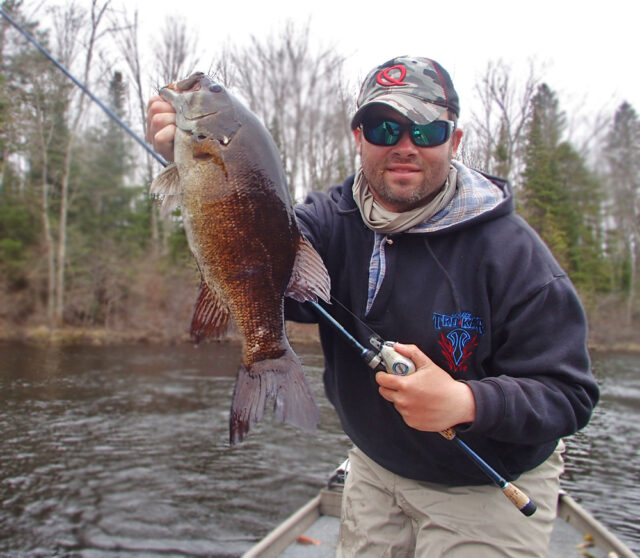
The same pattern was replicated at another pool, located several miles away from the first location.
Had I anticipated this pattern much sooner, a 38 fish trip between two locations could have potentially been more substantial had I visited additional staging sites.
Many smallmouth were left on the table, but I was blessed to catch over 30 quality specimens while 99% of the river was empty. Each individual fish was appreciated with a smile, and thanked.
Baits and tactics wise, one 6ft 10″ medium heavy-fast casting rod, 1 reel, with 1 DT-4 crankbait was needed all day, whose 10 lb. fluorocarbon line required a retie every 5 fish. This was the simplest and most minimalist I had ever succeeded with!
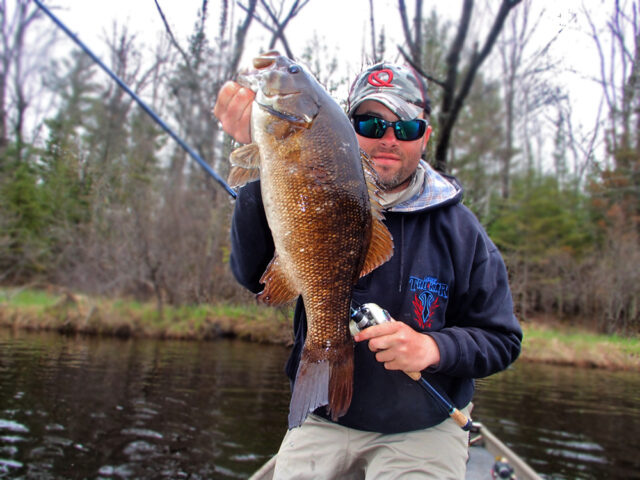
Data Collection
Having described the profile of my smallmouth collection sites and the early spring season behavior of my home river system, the same patterns will hold true on your river systems where smallmouth can be both resident and non-resident fish.
On my particular system, I’d calculate, with support of the DNR’s prior telemetry studies elsewhere, 90% of the smallmouth residing in my pools each spring are non-resident river fish who reside in flowages for majority of the year only to migrate upstream seeking pristine undisturbed, unexploited spawning habitats and plentiful food supply the river upstream luxuriously provides them. Seek and locate a staging pool at every river near you.
The vulnerable never know any better, and this holds true for our trophy smallmouth bass populations. The same river fish I catch every spring are repeats, proving how vulnerable, at-risk, and limited supply river fisheries can be. Every trophy adult smallmouth caught is thankful for our mandatory spring catch and release season, and giving them sanctuary to procreate future generations of their population.
While substantial migrations in spring are documented to exist, few other anglers and even biologists have been able to accumulate substantiated data to further this migrant fishes telemetry study. The exploits from May 18, 2020 confirms everything I knew all along about my river’s fishery and its long-distance smallmouth migrations in spring. Experiencing the best river smallmouth fishing of spring relies on the calculated anticipation of migration, understanding of a river’s configuration and hidden underwater locations, and its smallmouth population’s seasonal tendencies.
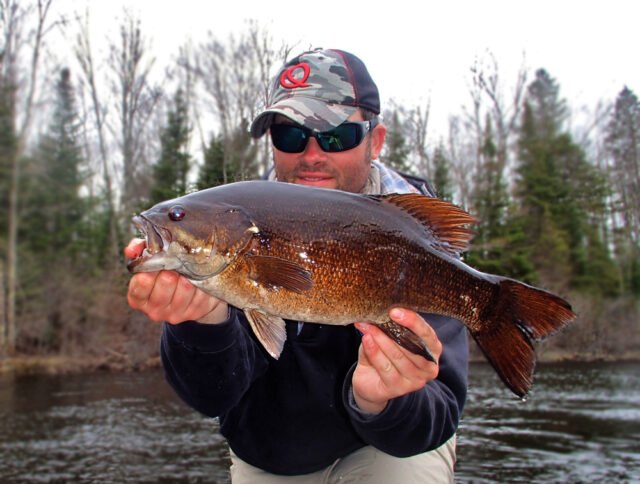
Andrew Ragas splits time between the Chicago area and Wisconsin’s Northwoods. Based in Minocqua, WI, he specializes in trophy bass fishing and offers guided trips from May thru October. While big bass is the passion, he dabbles in multi-species as well. He may be visited online at www.northwoodsbass.com


